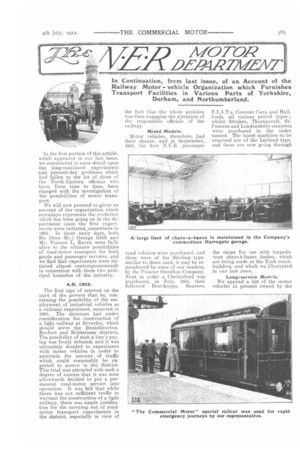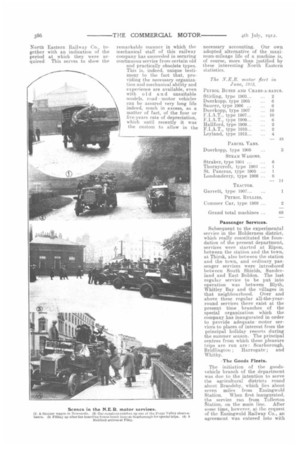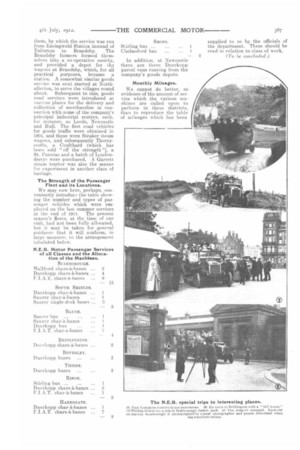In Continuation, Continuation, from last issue, of an Account of
Page 5

Page 6

Page 7

If you've noticed an error in this article please click here to report it so we can fix it.
the Railway Motor vehicle Organization which Furnishes Transport Facilities in Various Parts of Yorkshire, Durham, and Northumberland.
In the first portion of this article, which appeared in our last issue, we commented in some detail upon the long-continued experiments and present-day problems which had fallen to the lot of those of the North-Eastern officials who have, from time to time, been charged with the investigation of the possibilities of motor transport.
We will now proceed to given an account of the organization which nowadays represents the evolution which has been going on in the department since the first experiments were initiated, somewhere in 1903. In those early days, both Sir (then Mr.) George Gibb and Mr. Vincent L. Raven were fully alive to the ultimate possibilities of road-motor transport for both goods and passenger services, and we find that experiments were initiated almost contemporaneously in connection with these two principal branches of the industry.
A.D. 1903.
The first sign of interest on the part of the powers that be, concerning the possibility of the employment of industrial vehicles as a rational experiment, occurred in 1903. The directors had under consideration the construction of a light railway at Beverley, which should serve the Brandsburton, Beefort and Holderness districts. The possibility of such a line's paying was freely debated, and it was ultimately decided to experiment with motor vehicles in order to ascertain the amount of traffic which could reasonably be expected to accrue in the district. This trial was attended with such a degree of success that it was soon afterwards decided to put a permanent road-motor service into operation. It was felt that while there was not sufficient traffic to warrant the construction of a light railway, there was ample justification for the carrying out of roadmotor transport experiments in the district, especially in view of the fact that the whole problem was then engaging the attention of the responsible officials of the railway.
Mixed Models.
Motor vehicles, therefore, had their chance, and in September, 1903, the first N.E.R. passenger road vehicles were purchased, and these were of the Stirling type, similar to those used, it may be remembered by some of our readers, by the Pioneer Omnibus Company. Next in order a Chelmsford was purchased, in July, 1904, then followed Duerkopps, Saurers, F.I.A.T.s, Commer Cars, and Halllords, all various petrol types ; whilst Straker, Thornycroft, St.. Pancras and Londonderry steamers were purchased in the order named. The latest. machines to be acquired are of the Leyland type, and these are now geing through the shops for use with torpedo. type chars-a-bancs bodies, which are being made at the York coachbuilders, and which we illustrated in our last issue.
Long-service ModPls.
We append a list of the motor vehicles at present owned by the North gether period allured
Eastern Railway Co., towith an indication of the at which they were RCThis serves to show the remarkable manner in which the mechanical staff of this railway company has succeeded in securing continuous service from certain old and practically obsolete types. This is, indeed, unique testimony to the fact that, providing the necessary organization and mechanical ability and experience are available, even with old and unsuitable models, road -,motor vehicles can be assured very long life indeed, much in excess, as a matter of fact, of the four or five-years rate of depreciation, which until recently it was the custom to allow in the
necessary accounting. Our own adopted alternative of the maximum-mileage life of a machine is, of course, more than justified by these interesting North Eastern statistics.
The N.E.R. motor fleet in June, 1912.
PETROL BCSES AND CHARS-A-BANCS.
Stirling, type 1903... . . 2
Duerkopp, type 1905 ... 6 Saurer, type 1906 ... 6 Duerkopp, type 1907 . 10
E.I.A.T., type 1907... 10 F.I.A.T., type 1909... ... 6 Hallford, type 1909... 2
F.I.A.T., type 1910... 2
Leyland, type 1912... 4
Passenger Services.
Subsequent to the experimental service in the Holderness district, which really constituted the foundation of the present department, services were started at Ripon, between the station and the town, at Thirsk, also between the station and the town, and ordinary passenger services were introduced between South Shields, Sunderland and East Boldon. The last regular service to be put into operation was between Blyth, Whitley Bay and the villages in that neighbourhood. Over and above these regular all-the-yearround services there exist at the present time branches of the special organization which the company.has inaugurated in order to provide adequate motor services to places of interest from the principal holiday resorts during the summer season. The principal centres from which these pleasure trips are run are : Scarborough, Bridlington ; Harrogate ; and Whitby.
The Goods Fleets.
The initiation of the goodsvehicle branch of the department was due to the intention to serve the agricultural districts round about Brandsby, which lies about seven miles from Easingwold Station. When first inaugurated, the service ran from Tollerton Station, on the main line. After some time, however, at the request of the Easingwold Railway Co., an agreement was entered into with
them, by winch the service was run from Easingwold Station instead of Tollerton to Brandsby. The Brandsby farmers formed themselves into a co-operative society, and provided a depot for the wagons at Brandsby, which, for all practical purposes, became a station. A somewhat similar goods servioo was next started at Northallerton, to serve the villages round about. Subsequent to this, goods road services were introduced at various places for the delivery and collection of merchandise in connection with some of the company's principal industrial centres, such, for instance, as Leeds, Newcastle and Hull, The first road vehicles for goods traffic were obtained in 1904, and these were Straker steam wagons, and subsequently Thornyc ro Its, a Coulthard (which has been sold "off the strength "), St. Pancras and a batch of Londonderrys were purchased. A Garrett steam tractor was also the means for experiment in another class of haulage.
The Strength of the Passenger Fleet and its Locations.
We may now here, perhaps, conveniently introduc3 the table showing the number and types of passenger vehicles which were employed on the last summer services at the end of 1911. The present season's fleets, at the time of our visit, had not been fully allocated, but it may be taken for general guidance that it will conform, in large measure, to the arrangement tabulated below.
SHOPS.
Stirling bus ... ... I Chelmsford bus ,., ...
In addition, at Newcastle there are three Duerkopp parcel vans running from the company's goods depots.
Monthly Mileages.
We cannot do better, as evidence of the amount of service which the various machines are called upon to perform in these districts, than to reproduce the table of mileages which has been supplied to us by the officials of the department. These should be read in relation to class of work.






































